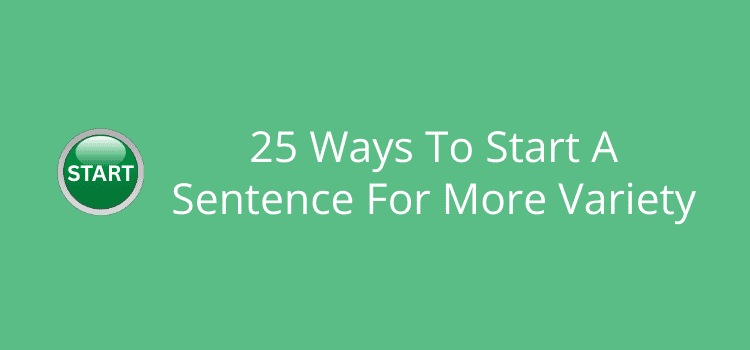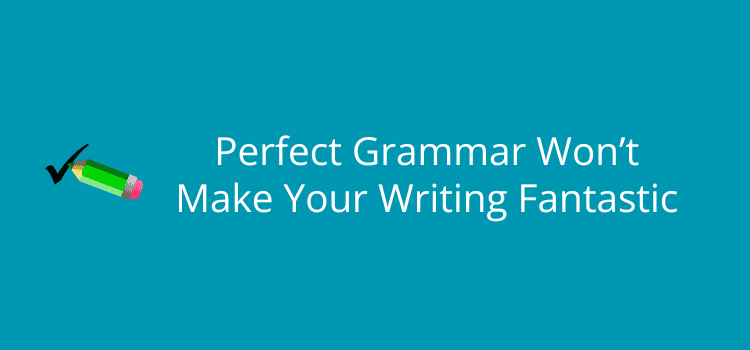
How much thought do you give to the ways you start a sentence?
Because you do it every ten, fifteen, or twenty words, it’s easy to overlook the first few words you use.
Maybe you don’t realize it, but are your sentences often beginning with I, he, she, or the or an? Perhaps, there is, and there are?
All writers have tics or reflex habits, but they can stand out more in the first few words of a sentence. It’s an area where variety certainly counts.
Why varying your sentence starters matters
Readers definitely notice patterns in writing, even if they don’t realize it.
If you start every sentence in a similar way, such as using I too often, it can make your writing feel repetitive or dull.
Variety helps keep your writing more lively by giving each sentence a reason or purpose.
You can emphasize key points and guide a reader’s attention more naturally.
Mixing up your sentence openings can definitely help your writing avoid a lot of unnecessary repetition.
Right from the first word, you can convey tone, such as curiosity, urgency, calm, or suspense.
In dialogue or narrative, sentence variety can stop your characters’ voices from falling flat.
Even with nonfiction, varied sentence beginnings make explanations easier to follow and understand.
Over time, consciously trying and experimenting with different openings will strengthen not only your sentences but also your writing skills.
Logically, the first words of your sentences should be powerful, because they set the stage for everything that follows.
25 Ideas to start your sentences
I’m sure you understand why sentence variety matters, so let’s get practical.
Here are twenty-five options for starting sentences that will immediately add energy and interest to your writing.
But note, none of these examples are rules, and you don’t have to use all of them.
However, these options can give you the tools you need to break habits and experiment with fresh openings.
Mix and match and try them in different contexts, and see how they can improve your writing.
Think of this list as your toolbox. The more ways you can start a sentence, the more control you will have over your tone, pacing, and clarity.
1. Subject-First
Yes, it’s a standard starter, but when followed by a strong or action verb, it always works well.
Cats play by their own rules.
2. Adjective-First
Try leading with a descriptive word or phrase to set a mood.
Hot and humid, the morning warned of the torrid day to come.
3. Adverb-First
An adverb can instantly show how an action occurs.
Abruptly, our manager ended the heated meeting.
4. Prepositional Phrase
It’s a quick way to indicate location, time, or condition to set up a sentence.
In the centre of the city, thousands of protesters began to gather.
5. Conjunctions
Words like but, and, yet, or so link ideas or add surprise.
Yet the plan failed, despite the meticulous planning.
6. Transition Words or Phrases
Transitions can give a sentence a sense of time or flow.
Meanwhile, the concert raged on despite the weather.
7. Questions
A quick and easy way to engage a reader.
Who could have predicted what happened next?
8. Exclamations/Interjections
Use it to express emotion or surprise.
Wow, that’s certainly not what we expected!
9. Gerunds/Participial Phrases
Starting with an ing verb shows ongoing action.
Driving through ice and snow, we somehow made it home safely.
10. Infinitive Phrases
Use to + verb to show a purpose or intention.
To succeed in business, you need to be tough and ruthless.
11. Dialogue or Quotes
Jumps into a character’s voice, or you can use a famous quotation.
I can’t believe this is happening, she said.
12. Conditional Clauses
Start with if, unless, or when to create anticipation.
If you take your time, you’ll manage to do it.
13. Absolute Phrases
Add a descriptive clause that modifies the whole sentence.
Her teeth clenched, she waited impatiently.
14. Appositives
Start with a noun phrase that describes your subject.
A talented guitarist, my brother played with many famous artists.
15. Similes or Metaphors
Start with a comparison to create immediate imagery.
Like a sly fox, he always weaselled his way out of trouble.
16. Sound Effects / Onomatopoeia
A striking sound is great for grabbing attention.
Boom! The market fell in a flash.
17. Negative Statements
Open with what is not happening to add strong emphasis.
Hardly anyone expected her to succeed.
18. Contrast Sentences
Words such as although or while can create tension.
Although outnumbered, they refused to cede.
19. Lists / Enumerations
Starting with multiple items can create rhythm or emphasis.
White wine, cheese, and chocolate are all I need to survive my hectic days.
20. Single-Word Punch
You can open with a single, strong-word sentence for dramatic effect.
Tension. It filled the air as we waited for the results.
21. As / While
You can use as or while to show actions happening at the same time.
As she opened the envelope, her hands started to tremble.
22. Contradiction / Paradox
Start with a statement that is contradictory to create interest.
Less is more when it comes to good creative writing.
23. Historical or Contextual Reference
Start with a time, date, or historical fact.
In 1955, the space race began in earnest.
24. Command / Imperative
Begin with a verb to give an instruction or sense of urgency.
Stop, take your time, and start again.
25. Sensory Detail
Lead with a strong sense impression of smell, sight, touch, taste, or sound.
Hailstones clattered angrily on the roof, hinting that worse was to come.
Summary
Variety is the spice of life, so it must also be true for writing.
Try experimenting with different ways to start a sentence, whether it’s a question, an appositive, a negative statement, or even a paradox.
You can even look at moving the end of a sentence to the beginning to change focus, or break a sentence in two.
Your first few words of a sentence can really do some heavy lifting, because they set the tone and guide your reader through your ideas.
With practice, I’m sure you’ll notice that your writing becomes more dynamic, expressive, and confident.
All you have to do is take it one sentence at a time.
Related Reading: How To Describe The Sea Or Ocean In Writing
Share This Article


